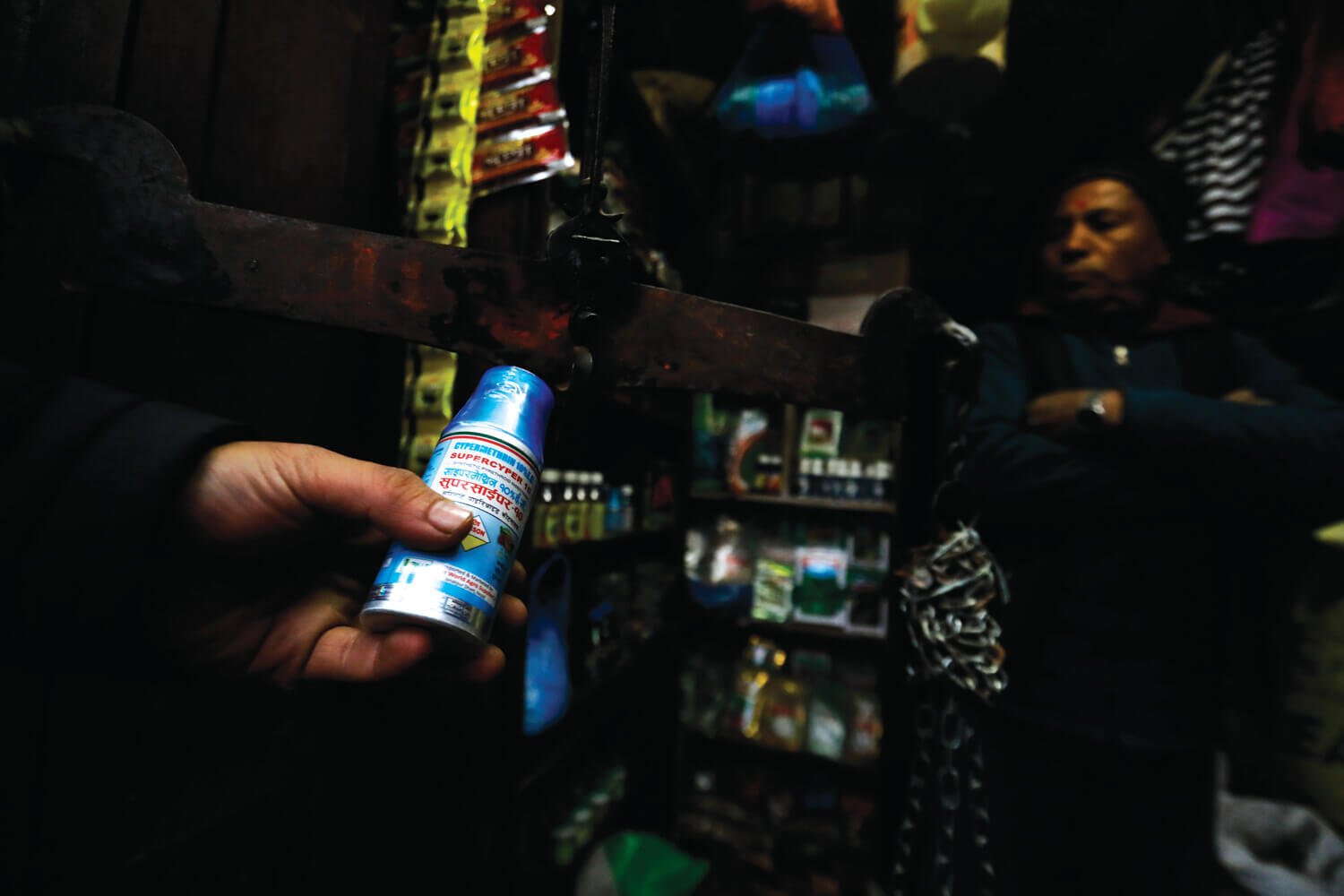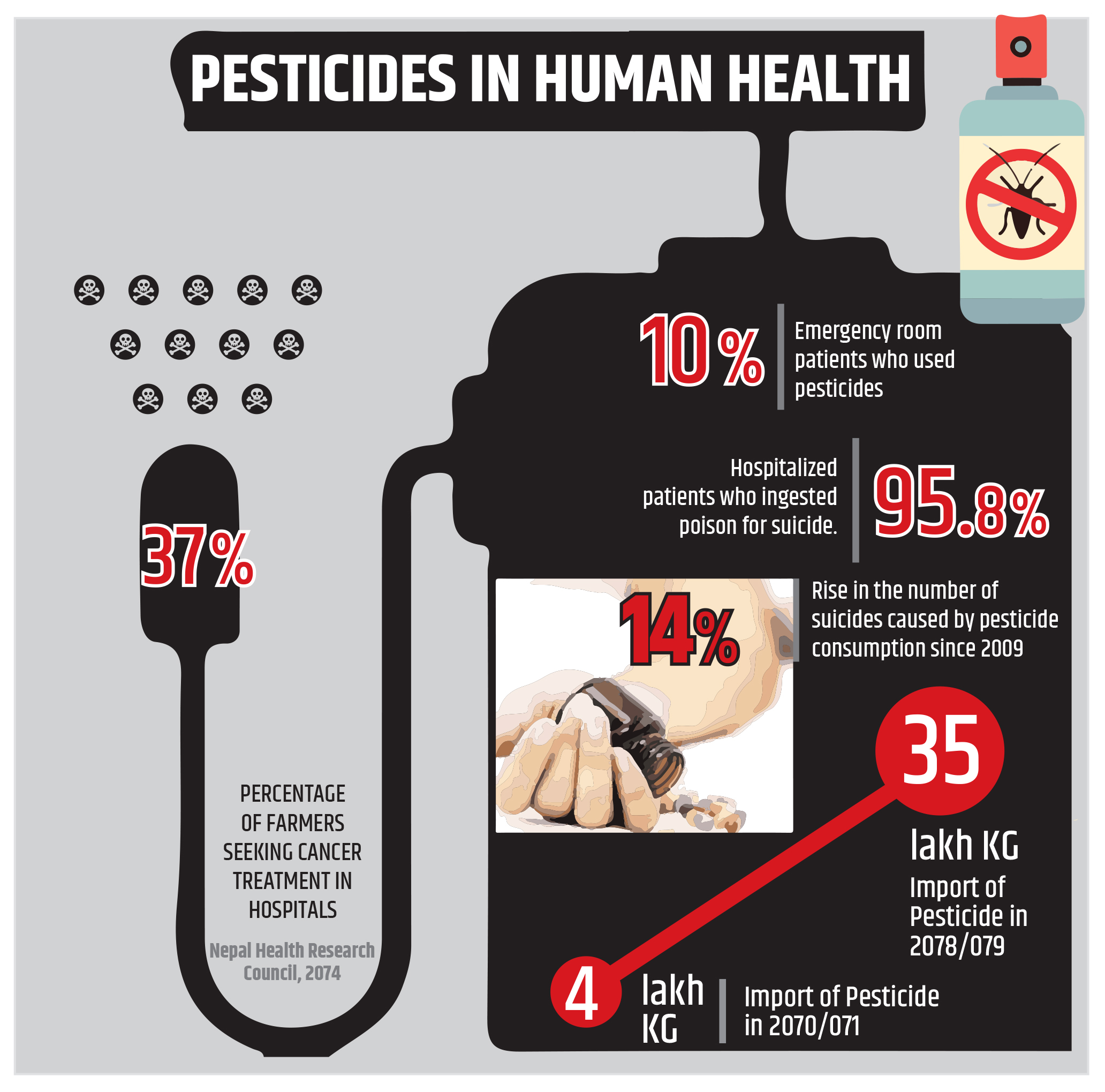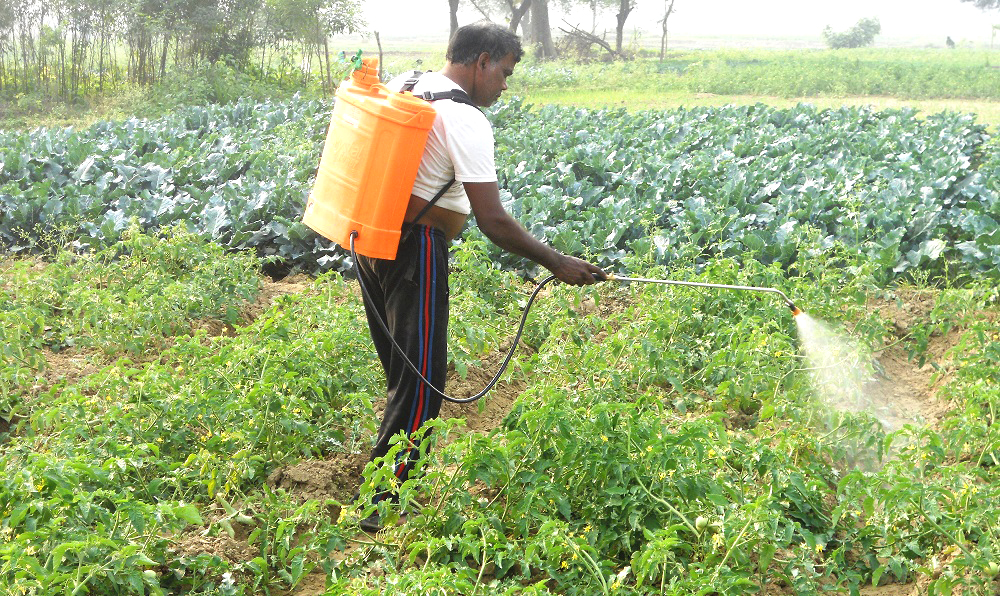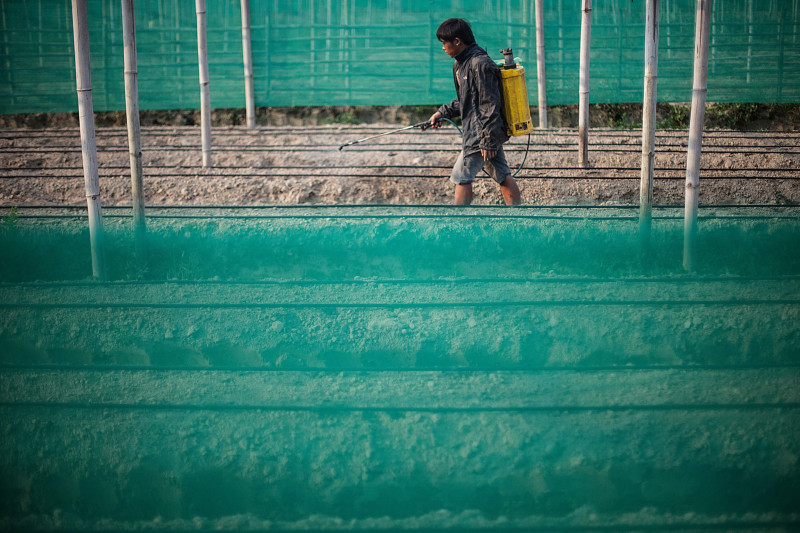Misuse of pesticides is becoming a major reason for deaths in Nepal. Research shows that the public health crisis caused by the government’s ignorance has already become too late to stop.
Sagar Budhathoki |CIJ Nepal
The Poison Information Centre of the TU Teaching Hospital received a phone call regarding an unconscious three month old child who had ingested Potassium Phosphate. Two months ago, the child was taken to a local clinic in Ilam after undeliberately consuming the chemical used in farming. The clinic had called the Centre for a specialist consultation. While Potassium Phosphate is less harmful than other pesticides and as only a bare minimum amount was ingested by the child, his treatment was possible in Ilam itself. Only one and a half months ago, a twenty one year old man died at the TU Teaching Hospital after ingested Alumnium Phosphide, a chemical used to kill mice.
Doctors report that misuse of pesticides is extremely high in Nepal as for every ten emergency cases at hospitals, one is a patient who has ingested pesticide. In 2004, 154 patients who had ingested pesticide were admitted at the Medical Ward and the Pediatric Ward of Patan Academy of Health Sciences. In a research paper prepared by Buddhi Prasad Poudyal in the academic journal of Nepal Medical Association, it was reported that among the 154 patients, 131 was adults and 23 were children. A comprehensive official figure does not exist, however, many reports have shown that misuse of pesticides has increased steeply in Nepal.

Farmers are buying pesticides. Photo: Monica Deupala/Himal Archive
According to an article entitled Intentional Pesticide Poisoning and Pesticide Suicide in Nepal published in Clinical Toxiology journal, the rate of deaths caused by ingestion of pesticide has increased by 14 percents since 2009. The Terai region has seen a huge crisis of pesticide misuse. The article stated that for every one lakh people in Terai, 251 individuals commit suicide by consuming pesticide used for farming. The research article used samples from viscera tests at ten big hospitals and two forensic science laboratories of Nepal between 2017 and 2020.
Nepal Police reports that ingestion of pesticide is one of the ten reasons for deaths in Nepal. Out of all the suicide incidents, misuse of pesticide climbs to the second position. According to a research carried out by Chief of the TU Teaching Hospital’s Poison Information Centre, Associate Professor Dr. Rakesh Ghimire and Former Director of the Agriculture Department Dr. Dilliram Sharma, of all the cases of pesticide poisoning, 95.8 percent are suicide cases. Only 0.03 percent of all cases are of those patients who undeliberately ingested pesticide. “Pesticide misuse has become a public health crisis in a developing country like Nepal,” said Dr. Ghimire.
According to a study carried out by Clinical Toxiology, suicidal deaths increased by 13 times from 1980 to 2018. In these 38 years, the study showed that of all individuals who committed suicides in Nepal, 23 percent ingested pesticide. 40 to 65 percent of the pesticide induced suicides saw the use of Aluminium Phosphide.
Banned pesticides are used more
As pesticide induced suicides have increased in number, Dr. Sharma and Dr. Ghimire recommended Center for Pesticide Control and Management of the Ministry of Agriculture and Livestock Development to ban Aluminium Phosphide and Dichlorvos. The Ministry then banned the two pesticides in 2019. However, as they are easily available in Nepali markets, many individuals have used them for committing suicide. Dr. Rishika Karki from the Poison Information Centre of TU Teaching Hospital said that misuse of banned pesticides has not decrased. The government had prohibited the used of Methyl Parathion in 2007, however, there are many patients that are brought to the Centre after ingesting it with an intention to commit suicide.

Harmful pesticide glyphosate. Photo: Gopen Rai
The Plant Quarantine and Insecticide Management Centre has banned 24 pesticides till date as they had negatively impacted health of people and environment. However, they are still freely found in the market. An expert on pesticide, Dr. Dilliram Sharma stressed that certain chemicals such as Chlorpyrifos – an insecticide, Herbicide that kills weed, and Zinc Phosphide that kills mouse, need to be immediately banned for their misuse by people. They are sold in dozens of brandnames in Nepali market, among which Glyphosate is a widely used brand.
As President John F Kennedy permitted the use of a herbicide called Agent Orange, the American military started using it in South Vietnam from 12th January, 1962. Agent Orange was used with an intention of destroying forests and agricultural land used by the Viet Cong rebels. Until 1971, the American military sprayed around 19 million gallons (about 7 crore litres) of Agent Orange in South Vietnam. The Vietnamese government estimates that the Operation Ranch Hand caused different types of illness in 30 lakh people. The Vietnam Redcross estimates that 10 lakh people became disabled due to the effects of Agent Orange. The Environmental Modification Convention prohibited Herbicidal Warfare in 1978, however, Glyphosate – a pesticide as dangerous as Agent Orange – is easily available in Nepali markets.
Vegetables do not grow without pesticides!
Arjun Thapaliya, a farmer growing vegetables in 5 bigga of land in Golbazar of Siraha said that the yield will not increase without increasing the use of pesticide each year. Although he is aware of the dangers of pesticide in human health, he claims that he is forced to do so. He sprays pesticide as suggested by a local seller, which is extremely higher in quantity than the officially recommended amount.
According to the National Agriculture Census, in 2078, there has been an increase of 15.6 percent among farmers who use pesticide in paddy compared to the figures of 2068. The increase in use of pesticide can also be confirmed by the amount of imported pesticide in the last decade. In the fiscal year 2070/71, 4 lakh kilogram of pesticide was imported, while in 2078/79, the figure went up to 35 lakh kilogram. According to the report, out of 41 lakh 30 thousand farming families, 5 lakh 80 thousand families use pesticide in their production process. About 3 lakh 51 thousand families use extremely harmful pesticide. 70 thousand farmers from 39 districts use the pesticide banned by the government.
5 lakh 28 thousand farmers producing green vegetables use pesticide, among which 3 thousand 857 farmers use harmful pesticide not yet permitted by the government. 68 thousand farmers use pesticide products that are the most harmful with ‘yellow’ category. The Pesticide Management Centre has 131 common categories of pesticide with 3032 brand names.
Although Nepali farmers are increasing their usage of pesticide every year, the examples of Sweden and Indonesia show that this is a wrong path to travel. Sweden decreased its use of pesticide by 68 percent and public health poisoning by 77 percent. However, this has not decreased its agricultural production. Likewise, Indonesia decreased its use of pesticide by 65 percent, which actually led to an increase in the paddy production by 12 percent. India has also taken the policy to decrease the use of pesticide.

In Nepal, farmers without the pesticide management training spray three times more pesticide on their crops than trained farmers. InTechOpen journal reported that the untrained farmers use pesticide 2.7 times more than the trained ones. The study found out that more than 60 percent of farmers use pesticide without any training and professional assistance.
According to another study conducted by Food and Agritulture Organization (FAO) of the United Nations in 2016, 25 percent of pesticide in the world is used by developing countries. Whereas, of all the deaths related to pesticide, the countries bear 90 percent of the deaths. A research conducted by Nepal Health Research Council in 2071 also showed that there is an extremely high use of pesticide in agriculture, as farmers do not maintain adequate security measures. The participants in the research used pesticide banned by the government, suffered from long term health complexities, and some individuals had ingested the poison due to erroneous management of pesticide.
Serious Health Crisis
Acoording to National Cancer Registry published by Nepal Health Research Council in Magh, 2074, 37 percent of all cancer patients in Nepal are farmers. The study indicated that the reason could be the excessive use of pesticide in the agriculture sector of Nepal. The data collected from Chitwan’s BP Koirala Memorial Cancer Hospital, Kathmandu’s Bir Hospital and Kanti Children Hospital, and Pokhara’s Manipal Teaching Hospital demonstrated that during the decade of the study, out of 56 thousand and 13 admitted cancer patients, 20 thousand and 953 patients were farmers.
Chiniya Devi Thakurani from Parsa’s Jirapani is one of the cancer patients. She sprayed pesticide on tobacco, paddy and barley among other crops, without using any safety meaures. Afer suffering from breathing issues, she went to the hospital, which later diagnosed her with lung cancer. Currently, she is in Bangalore for the treatment. Her brother-in-law said that the doctor confirmed that her cancer emerged from continuous contact with pesticide. Before contacting pesticide, farmers must use proper glasses, mask, gloves, jacket and head gear. However, most farmers do not use such safety measures.

Farmers spray pesticides on crops. Photo: Govind Bhandari/Nepali Times
Although all pesticides are detrimental to human health, the Government of Nepal has specified the amount of each type of pesticide for crops based on its ability to harm. But as monitoring of the pesticide use is weak, areas with successful professional farming face increasing use of banned pesticide. According to the National Agriculture Census, 2078, Kavre and Bhaktapur of the hilly region, and Dang and districts bordering India suffer from indiscriminate use of pesticide.
Individuals who are in regular contact with pesticide are prone to health complexities in the long run, such as, cancer, tumour, breathing issues and disability in offsprings. According to an article written by Suhil Neupane in InTechOpen Journal in 2021, such individuals are likely to have weak immune systems, compromised liver and reproductive ability, mental illness, long-term allergies and paralysis.
A research published in 2019 and carried out by researchers Sagar GC and Jyoti Neupane of Agriculture and Forestry University found out that every year the use of pesticide increases by 10 percent in Nepal. The research further noted that this increase negatively impacts the health of pregnant women. A public health expert, Dr. Sharad Wanta said, “Increase in kidney failure and cancer in Nepal may be attributed to the use of pesticide. However, without proper research, we cannot establish the causation.”
Government’s ignorance
Misuse of pesticide used in agriculture has resulted in crisis in human health and environment, as well as, increased the rate of suicide. Therefore, experts recommend the government to regulate the import, storage and use of pesticide. “There must be a clinical research on farmers spraying pesticide on crops and consumers. If the use of pesticide is not immediately regulated, then the results will be disastrous,” said Dr. Wanta.
Meanwhile, the Pesticide Management Centre noted that farmers use banned pesticides imported from India illegally through the open border. Nepal and India have in total 171 border points, including the major and minor customs points. However, only 15 border points have offices of Plant Quarantine and Pesticide Management Centre with limited human resources.

Before planting tomatoes, Deep Ale Magar of Luvhu, Lalitpur, uses organic insecticides to manage the harmful aphid. Image: Vikram Rai/ Himal Archive
While implementing the federal structure, the federal government dismissed the district mechanism of agriculture, while establishing Agriculture Knowledge Centre at the provincial level and appointing agriculture expert at the local level. With this change, the provision of having a pesticide inspector in each district was also scrapped. Hence, pesticide control at the local level is now dependent upon the agriculture expert, a general expert, rather than dedicated pesticide inspectors.
The situation is so dire that there is now only one pesticide inspector in Karnali Province, two in Madhesh Province and other provinces do not have pesticide inspectors at all. Although Agriculture Knowledge Centre allocates a technician for two to three districts, their absence in pesticide control has resulted in extreme ignorance in the harmful and illegal use of pesticide.
The government implemented Pesticide Management Act 2076 with an intention to stop the misuse of pesticide. According to the Act, all sellers in Nepal must import pesticide by registering it at the registration section of Plant Quarantine and Pesticide Management Centre. The Act also stipulates that banned pesticide must not be bought or sold in the market. However, these pesticides are easily available to sell and consume. The Act encourages plant based and bio-pesticide, calls upon prohibiting the use of banned pesticide, and asks concerned authorities to properly manage expired pesticide.
The Act envisions a province-level pesticide management committee, which would monitor pesticides in market, carry out awareness programmes, and draft necessary rules, directive, work-plan and criteria to implement the Act. However, without the formation of the directive and the criteria, the Act is powerless. Pharmacist Kabin Malekhu, Executive Director of Ask Foundation, an organization working in the field of pesticide management said that the directive is very important to regulate the market transaction of harmful pesticide. He added that the misuse has increased steeply as sellers can sell without proper prior knowledge and buyers can buy without official VAT bills.



